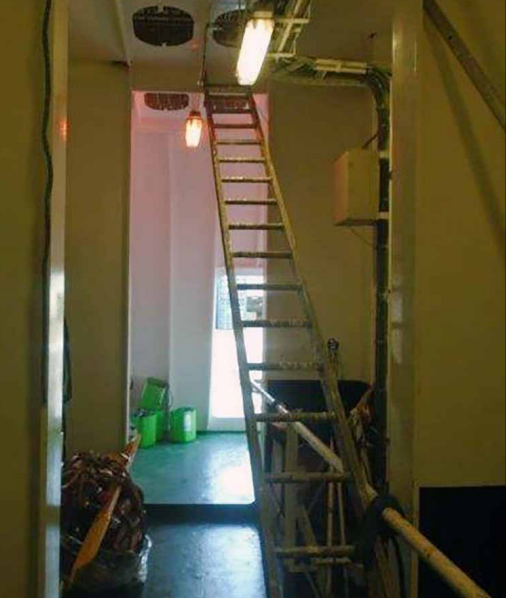The UK MAIB, in its recently published Safety Digest, focuses on a freight ro-ro vessel entering a port; Due to concerns of cold weather and disruptions to the vessel’s water pipe system, the master ordered to rig a temporary curtain arrangement in the corridor, at deckhead height, leading to the injury of a seafarer who used a ladder improperly, which led to the ladder slipping.
The incident
Specifically, as the roro vessel was entering the port, the master feared that the cold weather would seriously impact the water pipe system, an incident that had happened in the past in the sister vessel. The latter had faced problems with its frozen water pipes in the port side corridor, known as the ‘the wind tunnel’. The corridor was exposed to the elements at its forward end, and the relative wind caused by the vessel’s movement created a strong local wind effect.
Moreover, the master along with the chief engineer further discussed the issue and made the decision to rig a temporary curtain arrangement in the corridor, in order to protect the pipework. The master then ordered the bosun to establish a curtain, which would be hung at an opening in one of the frames, in the port side corridor reducing the wind effect.
The curtain establishment was to be in position in 3 weeks’ time, when the colder weather was close. Following the orders, the bosun placed the curtains and instructed the duty AB and the day-work AB to help him rig it.
The curtain had to be fitted at deckhead height, a distance of 3.5m. The bosun had already placed a ladder in position; at 5.4m length, it had a pitch angle of approximately 38º (Figure 1).

The duty AB was footing the ladder, the bosun climbed to the top of it and asked the day-work AB to pass him the dowel that he had already cut to size. Yet, the dowel was too short. After lunch, the afternoon duty AB made up the team with the bosun and day-work AB.
Following, when the duty AB saw the ladder arrangement he though of it being a little “dodgy” but didn’t say something because he was new onboard. Yet, he tied a small gauge rope around the ladder, securing it to the rail on one side approximately a third along its length.

He then measured the length required at the deck height, marking the dowel with a pen. The bosun then asked the day-work AB to fetch a saw. The duty AB was growing uneasy with the ladder arrangement as he struggled to maintain a decent footing. He asked the bosun to come down, but the bosun reassured him that all was well.
A bit later, the ladder slipped, out of the blue, twisted and threw the bosun to the deck. Consequently, the bosun landed on the opening’s raised coaming and after receiving first aid onboard, he was airlifted to a hospital.
Because of the falling, the bosun suffered fractures to his shoulder and hip and had a small brain bleed. The bosun remained in hospital for 5 days before being discharged home.
Lessons Learned:
- The bosun had no permit in operating at height, on the contrary to the ship’s safety system; A permit to work may extend the time required to complete a task, but the risk assessment element is vital to the safety of all concerned. In this case, had an assessment been completed, it is likely that another method of rigging the curtain would have been identified, eliminating the requirement to work at height altogether.
- The ladder’s pitch angle of approximately 38° was clearly not suitable
According to the Code of Safe Working Practices, section 17: Portable ladders should be pitched at 75° from the horizontal, properly secured against slipping or shifting sideways and be so placed as to afford a clearance of at least 150 mm behind the rungs. Where practicable, the ladder should extend to at least 1 metre above any upper landing place unless there are other suitable handholds. - The deck rating did not share his concern about the method being used to reach the work site because he was new to the vessel. Raising a question about a task can be tricky, especially when it requires challenging a senior crew member.
- Working at height should be avoided whenever possible but, if it is necessary, the correct equipment must be used and rigged correctly.




























































